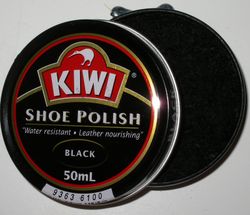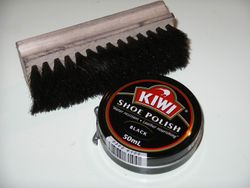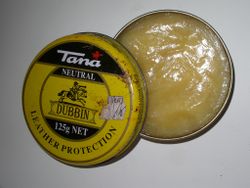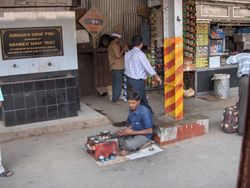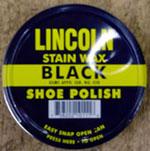Shoe polish
2007 Schools Wikipedia Selection. Related subjects: Everyday life
Shoe polish (or boot polish), usually a waxy paste or a cream, is a consumer product used to shine, waterproof, and restore the appearance of leather shoes or boots, thereby extending the footwear's life.
Various substances have been used as shoe polish for hundreds of years, starting with natural substances such as wax and tallow. Modern polish formulae were introduced early in the 20th century and some products from that era, such as Kiwi (begun in 1906), are still in use today.
Today, shoe polish is usually made from a mix of natural and synthetic materials, including naphtha, turpentine, dyes, and gum arabic, using straightforward chemical engineering processes. Shoe polish can be toxic, and, if misused, can stain skin.
Usage
Shoe polish is applied to the shoe using a rag, cloth, or brush. Shoe polish is not a cleaning product, and therefore the footwear should be both clean and dry before application. A vigorous rubbing action to apply the polish evenly on the boot, followed by further buffing with a clean dry cloth or brush, usually provides good results. Another technique, known as spit-polishing or sweating, involves gently rubbing polish into the leather with a cloth and a drop of water or spit. This achieves the mirror-like, high-gloss finish known as a spit shine which is especially valued in military organizations. Polishes containing carnauba wax can be used as a protective coating to extend the life and look of a leather shoe. A less time-consuming method of achieving a high gloss finish is to buff the shoe with a nylon legging.
Shoe polish may also be purchased pre-soaked into a hard sponge, which can be used to buff leather without needing to apply any additional polish to either the leather or the sponge. This is usually known as an applicator. A number of companies that manufacture shoe care products also sell a liquid shoe polish in a squeezable plastic bottle, with a small sponge applicator at the end. To decrease its viscosity, bottled polish usually has a very low wax content.
There are many products closely related to shoe polish, but not strictly considered as such. Other chemical products may be used to clean and shine shoes — in particular whiteners for white shoes, and a variety of sprays and aerosols for cleaning and waterproofing suede shoes.
Although shoe polish is primarily intended for leather shoes, some brands specify that they may also be used on non-porous materials, such as vinyl. The polish is generally the same colour as the shoes it will be used upon, or it may be neutral, lacking any intrinsic colour.
Because of its viscosity, shoe polish can also be used as a makeshift lubricant.
History
Before the 20th century
Since medieval times, dubbin, a waxy product, was used to soften and waterproof leather; however, it did not impart shine. It was made from natural wax, oil and tallow. As leather with a high natural veneer became popular in the 18th century, a high glossy finish became important, particularly on shoes and boots. In most cases, a variety of homemade polishes were used to provide this finish, often with lanolin or beeswax as a base.
In the 19th century, many forms of shoe polish became available, yet were rarely referred to as shoe polish or boot polish. Instead, they were often called blacking (especially when mixed with lampblack), or simply continued to be referred to as dubbin. Tallow, an animal by-product, was used to manufacture a simple form of shoe polish at this time. Chicago, Illinois, where 82% of the meat consumed in the United States was processed, became a major shoe polish producing area for this reason.
Prior to 1906, shoe polish was not well known as a purchasable product, nor was it particularly sophisticated. While sales were not especially high, a few brands, like Nugget, were available in England during the 1800s. The practice of shining people’s shoes gradually caught on and soon many shoeshine boys in the city streets were offering shoe shines using a basic form of shoe polish along with a polishing cloth.
Modern polish
While a number of older leather preserving products existed (including the Irish brand Punch, which was first made in 1851, and the German brand, Erdal, which went on sale in 1901), the first shoe polish to resemble the modern varieties (aimed primarily at inducing shine) was Kiwi. Scottish expatriates William Ramsay and Hamilton McKellan began making "boot polish" in a small factory in 1904 in Melbourne, Australia. Their formula was a major improvement on previous brands. It preserved shoe leather, made it shine, and restored colour. By the time Kiwi Dark Tan was released in 1908, it incorporated agents that added suppleness and water resistance. Australian-made boot polish was then considered the world's best. Black and a range of colors became available, and exports to Britain, continental Europe, and New Zealand began.
He named the shoe polish after the kiwi, the national bird of New Zealand; Ramsay's wife, Annie Elizabeth Meek Ramsay, was a native of Oamaru, New Zealand. It has been suggested that, at a time when several symbols were weakly associated with New Zealand, the eventual spread of Kiwi shoe polish around the world enhanced Kiwi's popular appeal and promoted it at the expense of the others.
A rival brand in the early years was Cobra Boot Polish, based in Sydney. Cobra was noted for a series of cartoon advertisements in The Sydney Bulletin, starting in 1909, using a character called "Chunder Loo of Akim Foo." (The word chunder, meaning "to vomit", possibly originated through the rhyming slang of Chunder Loo and spew.)
Surge in popularity
At the end of the 19th century, leather shoes and boots became affordable to the masses, and with the outbreak of World War I in 1914, the demand for large numbers of polished army boots led to a need in the market for a product that would allow boots to be polished quickly, efficiently and easily. The polish was also used to shine leather belts, handgun holsters, and horse tack. This demand led to a rapid increase in the sales of shoe and boot polish. The popularity of Kiwi shoe polish spread throughout the British Commonwealth and the United States. Rival brands began to emerge, including Shinola (United States), Cherry Blossom (United Kingdom), Parwa (India), Jean Bart (France), and many others. Advertising became more prominent; many shoe polish brands used fictional figures or historical characters to spread awareness of their products.
Shoe polish was to be found just about everywhere Allied troops ventured. American war correspondent Walter Graeber wrote for TIME magazine from the Tobruk trenches in 1942 that "old tins of British-made Kiwi polish lay side by side with empty bottles of Chianti." A story indicative of the rise in global significance of shoe polish is told by Jean (Gertrude) Williams, a New Zealander who lived in Japan during the Allied occupation straight after World War II. American soldiers were then finding the dullness of their boots and shoes to be a handicap when trying to win the affections of Japanese women:
When the British Commonwealth Occupation Forces arrived in Japan — all with boots polished to a degree not known in the U.S. forces — the G.I.s were more conscious than ever of their feet. The secret was found to rest not only in spit and polish, but in the superior Australian boot polish, a commodity which was soon exchanged with the Americans on a fluctuating basis of so many packets of cigarettes for one can of Kiwi boot polish.
Soldiers returning from the war continued to use the product, leading to a further surge in its popularity. A few years after World War II, Kiwi opened a manufacturing plant in Philadelphia, making only black, brown, and neutral shoe polish in tins.
Modern day
Shoe polish products are low-value items that are infrequently purchased. Demand is inelastic or largely insensitive to price change, and sales volumes are generally low. In the shoe polish market as a whole, some 26% of sales are accounted for by pastes, 24% by creams, 23% by aerosols, and 13% by liquids. In recent years, the demand for shoe polish products has either been static or declined; one reason is the gradual replacement of formal footwear with sneakers for everyday use.
There are numerous brands available, as well as store brands. There are two chief areas of shoe polish sales: to the general public, and to specialists and trade, such as shoe repairers, and cobblers. The sales percentages between the two outlets are roughly comparable.
Kiwi remains the predominant shoe polish brand in most of the world, being sold in over 180 countries and holding a 53% market share worldwide. Today, it is manufactured in Australia, Canada, France, India, Pakistan, South Africa, Spain, the United Kingdom, and the United States. Other leading brands include Kelly's, Shinola, Lincoln Shoe Polish, Meltonian, Angelus, and Cherry Blossom.
Kiwi was acquired by the American company Sara Lee following its purchase of Reckitt and Colman in 1991 and Knomark in 1987. The Federal Trade Commission ruled that Sara Lee had to divest its ownership of these companies in 1994 to prevent it from becoming a monopoly. Since this ruling, Sara Lee has been prevented from acquiring any further assets or firms associated with chemical shoe care products in the United States without prior commission approval. The Competition Commission in the United Kingdom also investigated the potential monopoly of Sara Lee in the shoe care industry.
In India, shoeshine boys are known as boot polish boys, and can still be found in operation today, particularly at railway platforms.
Shoe polish can also be used to create graffiti, as its flow characteristics are well suited for the task.
Composition & Toxicology
Shoe polish consists of a waxy colloidal emulsion, a substance composed of a number of partially immiscible liquids and solids mixed together. It is usually made from ingredients including some or all of naphtha, lanolin, turpentine, wax (often Carnauba wax), gum arabic, ethylene glycol, and if required a colourant, such as carbon black or an azo dye (such as aniline yellow). It typically has a specific gravity of 0.8, is negligibly soluble in water, and is made of between 65 and 77% volatiles — usually naphtha. The high amount of volatile substances means that the shoe polish will dry out and harden after application, while retaining its shine.
Lanolin, a hydrophilic grease from wool-bearing animals such as sheep or goats, acts as both a waterproofing wax and a bonding agent, giving the shoe polish its greasy feel and texture. It also prevents the naphtha from evaporating until the polish has been spread and buffed into a thin film on the leather surface. An essential ingredient in shoe polish is a thickener; without this, the polish would be too runny, making it difficult to use. Gum arabic, a substance from two sub-Saharan species of the acacia tree, is commonly used to increase the viscosity of the product.
Shoe polish contains chemicals which can be absorbed through the skin, or inhaled. When handling shoe polish, one should ideally wear gloves, and stay in a well-ventilated area. Shoe polish should also be kept out of reach of children and animals. It can stain the skin for a protracted period of time, and will cause irritation to the eye if there is direct contact.
Manufacture
Shoe polish can be manufactured using large vats, reasonably powerful heaters and air conditioners. There is no set method of manufacture, although most methods use pressures of two atmospheres to ensure the naphtha does not boil off, and temperatures of up to 85 °C.
The first step in the manufacture of a typical shoe polish is the melting of the wax with the highest melting point in an electric heater. Following this, all other waxes are added, usually by descending order of melting point. Whilst this wax is held at a constant temperature, the emulsion — a mixture of the various oils and, if used, fats, is then heated separately, at around 85 °C. The heated emulsion is then added to the waxes, along with distilled water. When the mixture reaches around 80 °C, turpentine oil is added. This mixture is then mixed and continually stirred for half an hour. Dyes are added and mixed in turpentine oil if it is not a neutral polish. The mixed mass is reduced slowly to 50 °C, and as its viscosity increases, it is poured through a closed funnel into a cooling chamber. The poured mass is allowed to settle slowly, providing uniform distribution. The process is considered straightforward and the required equipment is relatively easy to acquire. The cost of establishing shoe polish manufacturing facilities has been estimated at around $600,000 ( as of 2005).
Shoe polish is traditionally packaged in flat, round, 60-gram (2-ounce) tins, usually with an easy-open facility. Because the amount of shoe polish that needs to be applied is small, and the shoe polish will desiccate due to volatile ingredients, such as naphtha, a large container would dry out before being fully used. The traditional flat, round tins have since become synonymous with shoe polishes.
Other methods
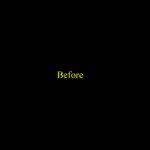
A banana peel can be used to effectively shine shoes.
